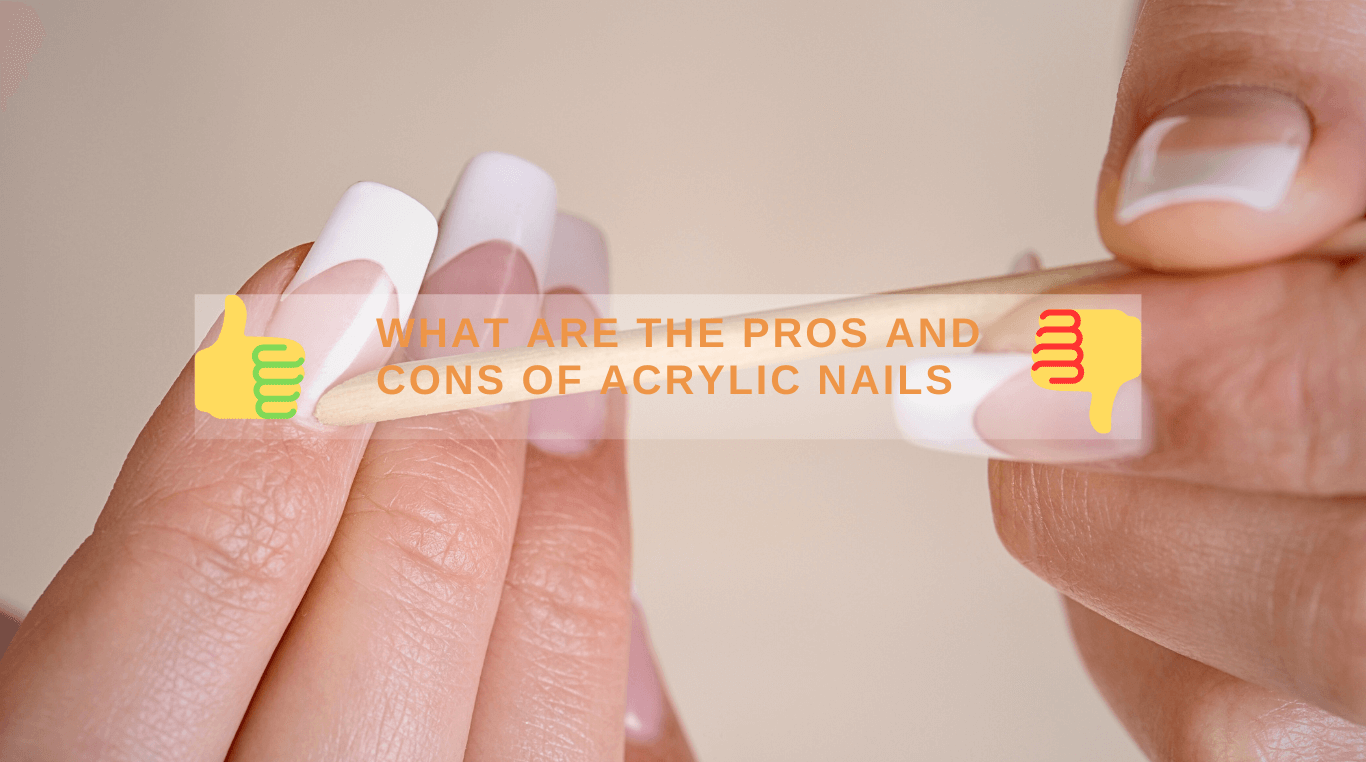Are you considering getting acrylic nails but wondering if they are worth it? You’re not alone. When it comes to enhancing the beauty of our hands, fake nails are the first thing that comes to mind.
But before you take the plunge, you must be well up on the advantages and disadvantages they offer.
In this blog post, I’ll discuss the ins and outs of acrylic nails to enable you to make an informed decision about whether they’re the right choice for you.
So let’s see what are the pros and cons of acrylic nails.
Pros:
- Durable and lasts longer
- It can be applied quickly.
- Providing various shapes and designs
- Easy Customization
- Instant lengthening
- Good for those with damaged nails
- Requires low maintenance
- Easily removable
- DIY manicure
Cons:
- Risk of damaging natural nails
- Infection, if not applied or cared for properly
- Requires regular fill-ins
- Lead to allergic reactions sometimes
- Nail thinning
After various experimental approaches by our team of beauty researchers and consulting with professional nail technicians and health experts, we have piled up this informative post to discuss the advantages and disadvantages of acrylic nails.
Pros of Acrylic Nails
- Durable and Lasts Longer
Acrylic nails are known for their durability and long-lasting nature. They are made by combining an acrylic liquid with a powder polymer that forms a hard and sturdy surface on your natural nails.
It helps them stay resistant to chipping and breaking compared to natural nails. This allows them to last for several weeks before needing a fill or maintenance.
- Quick Application
Acrylic nails can be applied relatively quickly by a professional nail technician or at home.
This efficiency makes acrylic nails a convenient option for those who want to have their nails done in a timely manner.
- Various Shapes and Designs
Acrylic nails contribute a range of shapes and design options. Whether you prefer square, round, oval, stiletto, or any other shape, acrylic nails can be sculpted and filed to match your desired style.
Additionally, they can be adorned with various nail art designs, including French tips, glitter, patterns, and even 3D decorations, and provide with you various possibilities.
- Easy Customization
One of the benefits of acrylic nails is that they can be easily customized to suit your style. You can choose the length you want, whether you like them short and natural-looking or long and dramatic.
Moreover, they can be customized with different colors, finishes, such as matte or glossy, and decorative elements.
- Instant Lengthening
If you have short natural nails and wish for longer nails, acrylics can provide instant length. The acrylic mixture is applied over your natural nails and extended with the help of nail forms or tips.
This helps you get the amount of length you require without waiting for your natural nails to grow out.
- Good For Those With Unattractive Nails
Acrylic nails can be worthwhile for individuals with damaged, brittle, unattractive, or weak nails. The acrylic overlay acts as a protective barrier to provide an extra layer of strength to your natural nails.
It helps prevent further breakage or splitting and makes your nails grow underneath the acrylics. Moreover, these synthetic nails are a blessing for women with inherited irregular or misshaped nails.
- Low Maintenance
Acrylic nails require minimal maintenance compared to some other types of nail enhancements. Once applied, they do not require frequent touch-ups or special care.
However, it is recommended to plan regular fills or maintenance appointments every 2-3 weeks to keep the nails looking their best and to maintain their integrity. Acrylic nail fill costs you lesser as compared to gel nails or other types of manicures.
- Easy Removal
When you decide to remove acrylic nails, the process can be relatively straightforward. While it is recommended to have them removed by a professional, it is also possible to take acrylic nails off with hot water at home.
Acrylic nails can also be soaked in acetone or wrapped in acetone-soaked cotton balls to loosen the bond between the acrylic overlay and your natural nails which makes the removal process easier and less harmful.
- DIY Manicure
You can do acrylic nails at home if you have the necessary skills and tools. There are acrylic nail kits available in the market that contain the acrylic liquid, powder, nail forms, and other essentials needed for the application.
With these things, you have the convenience of doing your own manicure if you prefer to take supervision of the process.
Cons of Acrylic Nails
- Damage To Natural Nails
One of the potential drawbacks of acrylic nails is the risk of damaging natural nails. The process of putting on these synthetic nails requires buffing and filing the surface of the natural nails to create a rough texture which can help nails adhere better.
However, these sanding procedures can weaken and thin the natural nails over time, leading to breakage and serious damage.
- Infection if Not Applied or Cared for Properly
Improper application or inadequate maintenance of acrylic nails can increase the risk of infection. When they are not applied correctly, gaps can form between the natural nail and the acrylic providing a space where bacteria or fungi can thrive.
Additionally, if proper hygiene practices are not followed, such as regular cleaning and disinfection, the risk of microbial growth can further escalate.
- Requires Regular Fill-ins
Acrylic nails require regular maintenance in the form of fill-ins or touch-ups. As the natural nails start to grow, there forms a gap between the cuticle and the acrylic that causes an uneven appearance.
To maintain a fresh look, fill-ins are needed every two to three weeks. The frequent visits to the nail salon for fill-ins can be time-consuming and may also incur additional costs.
- Risk of Allergic Reactions
Some individuals may develop allergic reactions to the chemicals present in acrylic nail products.
The monomer and polymer used in the acrylic mixture usually contain substances such as methacrylates, which can trigger allergic responses in sensitive individuals.
Symptoms of an allergic reaction can include redness, itching, swelling, and discomfort around the nails.
- Increased Nail Thinning
One of the lower hands of acrylic nails is that they cause nail thinning over time. The rough removal process is required to take off acrylics, which often involves soaking, cutting, and filing acrylic nails. This weakens and thins the natural nails.
Prolonged and repeated use of acrylic nails without proper care and breaks can result in long-term damage, which includes brittle and fragile nails.
Pros and Cons of Press On Nails?
Press-on nails are convenient and very simple to apply. They don’t require professional assistance, which makes them a cost-effective option.
They are synthesized in many designs and shapes, which can fulfill your wish to get customized nails without the commitment of traditional nail enhancements.
Press on nails are also a temporary solution and can be removed easily without using any professional method.
But the downside of press-on nails is they may not last as long as professionally applied acrylic or gel nails because their adherent becomes soft sooner, which provokes lifting or detachment.
What Are The Pros and Cons of Nail Tips?
The benefit of nail tips includes their comfortable and easy applications and budget-friendliness. Moreover, as they don’t use harsh chemicals, they are safer as compared to acrylic or gel enhancement.
However, they are not enduring and can be used just for a single event or might last for a few days. Moreover, they may not feel as natural as other manicures.
Is Gel or Acrylic Better For Weak Nails?
When it comes to weak nails, both gel and acrylic can have their own features, but it ultimately depends on the specific needs and the style you want.
Gel nails are generally considered more flexible and lightweight, which makes them a better choice for those with weak nails.
On the other hand, acrylic nails are also good if kept short. Longer nails will put extra stress on weak nails, making them more fragile.
However, I suggest you consult with a professional nail technician to assess the condition of your nails and determine the best option for you.
FAQs
Is acrylic bad for your nails?
Acrylic nails are not bad as long as you have them done professionally and you are concerned about their aftercare, like cleaning, avoiding too much moisture, and maintaining good nail hygiene. Moreover, removing them should also be done very gently.
Are there any benefits to acrylic nails?
Yes, acrylic nails have many benefits. They are a quick solution to get you a customized and stunning manicure. Moreover, they are affordable and provide one-time enhancements that can last for about a month.
What are the risks of acrylic?
The main risks of acrylic nails are infection, nail thinning, and allergic reactions. If you ignore caring and expose your nails to continuous unhygienic conditions, you’ll end up with fungal and bacterial nail or skin infections. In addition, frequent filing and buffing leads to thinning nail density.
Do acrylic nails break easily?
No, acrylic nails are quite strong, stable, and long-lasting and do not break easily. The reason is the acrylic material that is formed by blending a liquid monomer with a powder. It is a tough plastic material.
Conclusion On Pros And Cons Of Acrylic Nails
I will end up the topic with the fact that acrylic has brought a revolution in the industry of fashion and beauty and allowed humans to find temporary solutions to enhance their looks.
But at the same time, it possesses some hazards that should be taken into account and minimized. This is possible only via intensive research.


